Intel Dual-Core Mobile Ivy Bridge Launch and i5-3427U Ultrabook Review
by Jarred Walton on May 31, 2012 12:01 AM EST- Posted in
- Laptops
- CPUs
- Intel
- Ivy Bridge
- Ultrabook
Ivy Bridge Ultrabook Battery Life and Thermals
So far, we’ve seen pretty much what we expected from Ivy Bridge Ultrabooks: moderately to slightly faster CPU performance compared to the first generation Ultrabooks, and a bigger step up in graphics performance. This matches up quite well with our experience of quad-core Ivy Bridge and the ASUS N56VM, but where things took a turn for the worse was in battery life. Many expected Ivy Bridge to be a significant step forward for laptop battery life, but at least on the N56VM we didn’t see that. What about ULV Ivy Bridge? Is it better, the same, or worse? Check out our results:
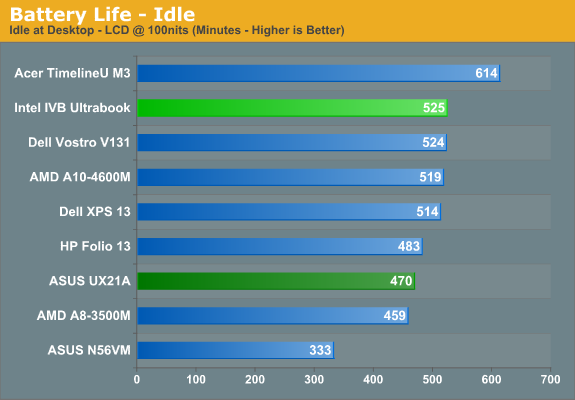
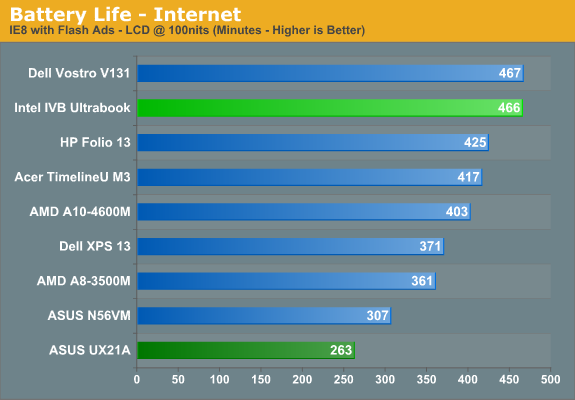
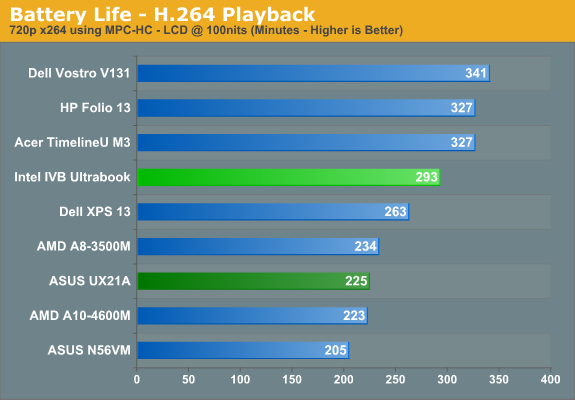
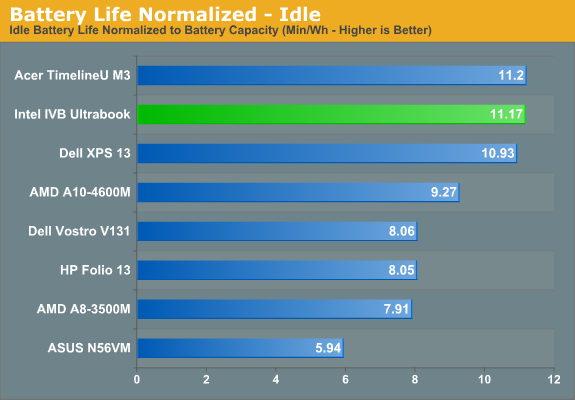
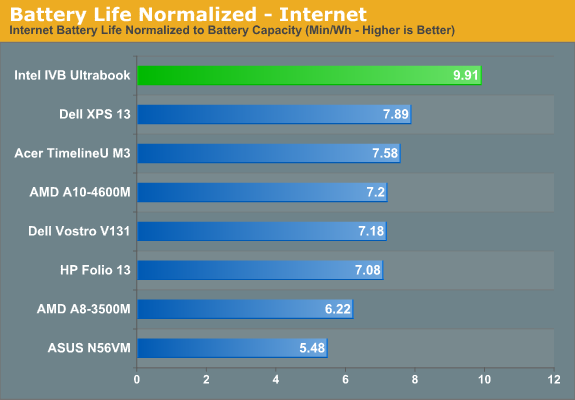
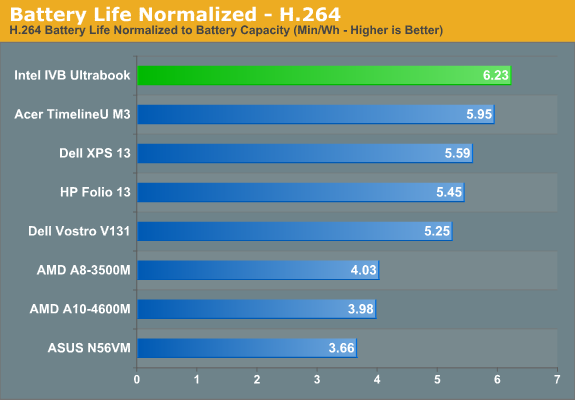
In terms of pure battery life, the Ivy Bridge prototype is good for nearly six hours of movie playback, close to eight hours of Internet surfing, and over 8.5 hours of idle time. It comes close to the top of our charts, though we could point out that the similar ASUS UX31E Sandy Bridge Ultrabook bests it in every category. Then again, ASUS has done very well in battery life comparisons for most of their laptops. Compared to the Acer S3, the IVB Ultrabook comes out ahead in Internet and behind in the other two disciplines; it does better against the Toshiba Portege Z830, Dell XPS 13, HP Folio 13, and matches or exceeds the Acer M3. Overall, given the improved performance, battery life looks to be similar or slightly better than Sandy Bridge Ultrabooks, which is quite acceptable.
We did run another battery life test looping 3DMark06 with the Balanced power profile and the IGP set to Balanced performance. Under those conditions, the PUB-RD Ultrabook lasted 107 minutes, which isn’t bad for that punishing workload.
As for thermals, this isn’t a production Ultrabook so these results aren’t particularly useful. Still, we ran our usual CPU+GPU stress test and here’s the HWMonitor screen capture:
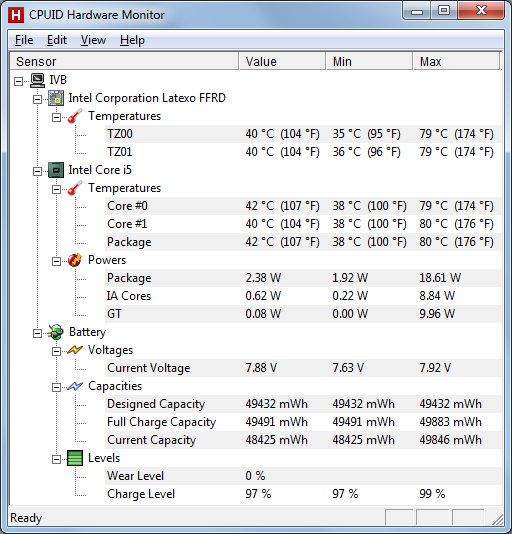
Thermals are reasonable under load at 79/80C, and most of that heat is right in the back-middle section of the chassis, so you’re not as apt to notice if you’ve got it resting on your lap. Along with the heat, let's quickly discuss acoustics.
The IVB Ultrabook is pretty much silent and registers well under the noise floor of our testing equipment during idle/light use, though the fan may occasionally spin up. Start running a few applications and depending on how hard they hit the CPU/GPU—and for how long—you’ll get a bump in noise to around 35dB. Under our stress test, which you’ll also get if you play any moderately demanding game or do some CPU intensive tasks, the Ultrabook becomes far more audible at 43dB. Again, given the not-for-resale nature of the system, it’s not something we’re particularly concerned with.

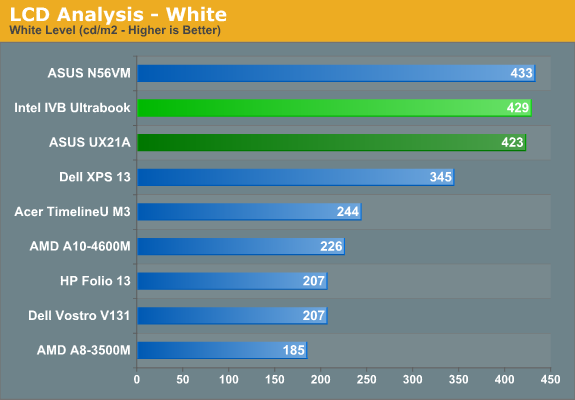
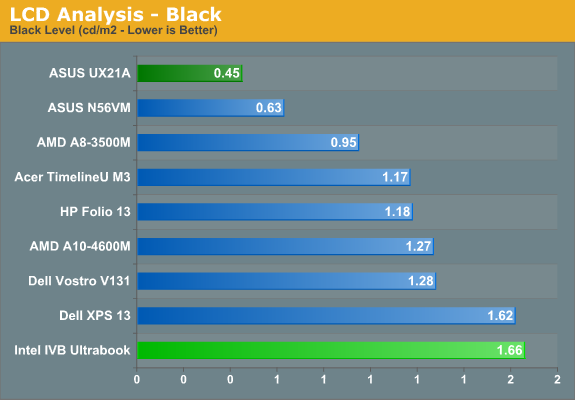
We’ve also run just a couple of the LCD tests; the LCD is the same one used in the ASUS UX31E, and the results are similar. You get a potentially bright LCD but with mediocre contrast and TN-quality viewing angles. Since this isn’t for sale, that’s perfectly acceptable, and given the choice between this panel and the 1366x768 junk so many Ultrabooks have shipped with, we'd definitely take this as an upgrade.










64 Comments
View All Comments
marioyohanes - Thursday, May 31, 2012 - link
Intel should learn from Apple users for the keyboard design... We all know how much Apple users hate white keyboard in previous MacBook models, that's why Apple is using black keyboard now...JarredWalton - Thursday, May 31, 2012 - link
Hahaha... I realized I never took a picture of the open laptop and so I used the image Intel sent along. I'll post an updated picture to the article in a moment, but suffice it to say that the review sample doesn't have a white keyboard.marioyohanes - Thursday, May 31, 2012 - link
I love the keyboard design on your new pic... :)kamalppc - Tuesday, January 29, 2013 - link
You can find the reviews here -http://cpudistro.com/intel/core-i5-3427u/
http://ultra-book.co/core-i5-3427u-review/
mcquade181 - Thursday, May 31, 2012 - link
I guess Apple users must value asthetics over funtionality!From a useablity point of view black keyboards are horrible.
In low light conditions it is very difficult to see individual keys, which, unless you can touch type, makes them very hard to use.
I suspect that's why there is so much desire for backlit keyboards.
Concillian - Sunday, June 3, 2012 - link
We should make keyboards for people who can't touch type?This is 2012 dude, if you can't touch type you have a problem. Everything you do in the business world and half the things in todays social world require using a keyboard of some kind as an input.
Catering hardware (and software) to the people who can't use them right ends up hindering productivity for those who are actually productive on their computer.
Argedut - Sunday, June 10, 2012 - link
You're totally right. Also if you don't understand the dewey decimal system don't even BOTHER looking for a job. Am I right?iwod - Thursday, May 31, 2012 - link
I am amazed by the Chipset TDP and die size, But as transistor shrinks but I/O lanes remain constant, may be we could further include things inside the chipset? Things like an SSD Controller? Or few years down the road there will be no more Chipset, just a SoC.Shadowmaster625 - Thursday, May 31, 2012 - link
The SSD controller should be right on the CPU die right next to the memory controller. But I guess Intel doesnt mind getting totally devoured by Apple, who was actually smart enough to make a chip with a flash controller. Granted its not a very fast one, but at least it is there.There is no reason why every new computer should not have at least 32GB of flash that reads just as fast as DRAM, and with DRAM caching, would basically write just as fast too. With the controller in the cpu it lowers the cost of 32GB to just a few dollars.... the current spot price of four 8Gbitx8 MLC NAND chips is just $18. With a good integrated flash controller, the lower latencies on random reads could bring the real world random read speeds well past even a Vertex 4.
ZeDestructor - Thursday, May 31, 2012 - link
What exactly is the difference between the QS77 and the QM77? As far as I can see, there's no reason to use the QM77 at all since the QS77 has a better TDP and power usage than the QM77 while retaining all the features...